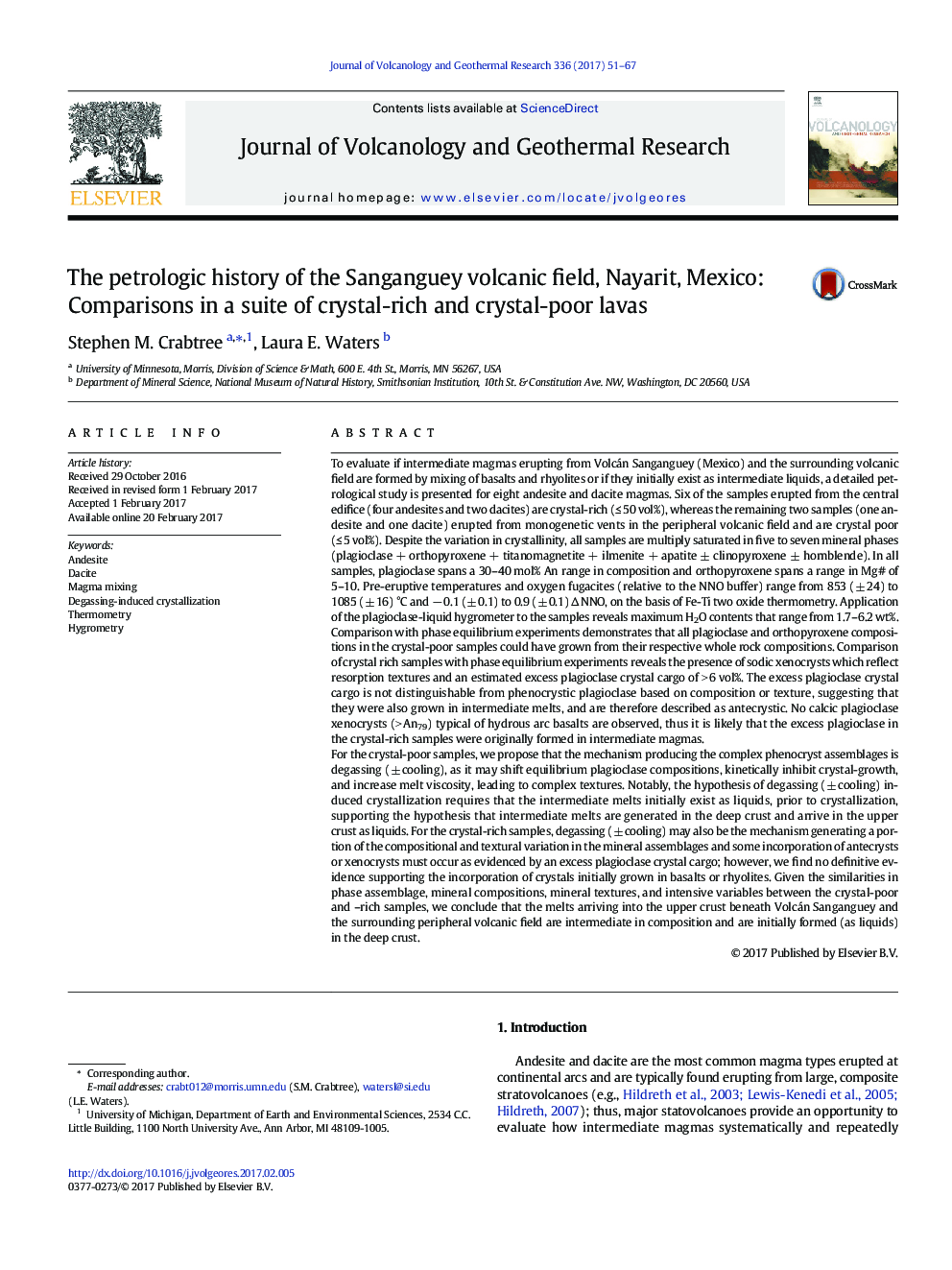| کد مقاله | کد نشریه | سال انتشار | مقاله انگلیسی | نسخه تمام متن |
|---|---|---|---|---|
| 5783857 | 1638287 | 2017 | 17 صفحه PDF | دانلود رایگان |

- Degassing (± cooling) induces crystallization in crystal-poor andesites and dacites.
- Xenocrysts in crystal-rich andesites and dacites are from intermediate magmas.
- No evidence is observed of mixing rhyolite and basalt beneath V. Sanganguey.
- Melts arriving beneath V. Sanganguey are intermediate, forming in the deep crust.
To evaluate if intermediate magmas erupting from Volcán Sanganguey (Mexico) and the surrounding volcanic field are formed by mixing of basalts and rhyolites or if they initially exist as intermediate liquids, a detailed petrological study is presented for eight andesite and dacite magmas. Six of the samples erupted from the central edifice (four andesites and two dacites) are crystal-rich (â¤Â 50 vol%), whereas the remaining two samples (one andesite and one dacite) erupted from monogenetic vents in the peripheral volcanic field and are crystal poor (â¤Â 5 vol%). Despite the variation in crystallinity, all samples are multiply saturated in five to seven mineral phases (plagioclase + orthopyroxene + titanomagnetite + ilmenite + apatite ± clinopyroxene ± hornblende). In all samples, plagioclase spans a 30-40 mol% An range in composition and orthopyroxene spans a range in Mg# of 5-10. Pre-eruptive temperatures and oxygen fugacites (relative to the NNO buffer) range from 853 (± 24) to 1085 (± 16) °C and â 0.1 (± 0.1) to 0.9 (± 0.1) â NNO, on the basis of Fe-Ti two oxide thermometry. Application of the plagioclase-liquid hygrometer to the samples reveals maximum H2O contents that range from 1.7-6.2 wt%. Comparison with phase equilibrium experiments demonstrates that all plagioclase and orthopyroxene compositions in the crystal-poor samples could have grown from their respective whole rock compositions. Comparison of crystal rich samples with phase equilibrium experiments reveals the presence of sodic xenocrysts which reflect resorption textures and an estimated excess plagioclase crystal cargo of > 6 vol%. The excess plagioclase crystal cargo is not distinguishable from phenocrystic plagioclase based on composition or texture, suggesting that they were also grown in intermediate melts, and are therefore described as antecrystic. No calcic plagioclase xenocrysts (> An79) typical of hydrous arc basalts are observed, thus it is likely that the excess plagioclase in the crystal-rich samples were originally formed in intermediate magmas.For the crystal-poor samples, we propose that the mechanism producing the complex phenocryst assemblages is degassing (± cooling), as it may shift equilibrium plagioclase compositions, kinetically inhibit crystal-growth, and increase melt viscosity, leading to complex textures. Notably, the hypothesis of degassing (± cooling) induced crystallization requires that the intermediate melts initially exist as liquids, prior to crystallization, supporting the hypothesis that intermediate melts are generated in the deep crust and arrive in the upper crust as liquids. For the crystal-rich samples, degassing (± cooling) may also be the mechanism generating a portion of the compositional and textural variation in the mineral assemblages and some incorporation of antecrysts or xenocrysts must occur as evidenced by an excess plagioclase crystal cargo; however, we find no definitive evidence supporting the incorporation of crystals initially grown in basalts or rhyolites. Given the similarities in phase assemblage, mineral compositions, mineral textures, and intensive variables between the crystal-poor and -rich samples, we conclude that the melts arriving into the upper crust beneath Volcán Sanganguey and the surrounding peripheral volcanic field are intermediate in composition and are initially formed (as liquids) in the deep crust.
Journal: Journal of Volcanology and Geothermal Research - Volume 336, 15 April 2017, Pages 51-67